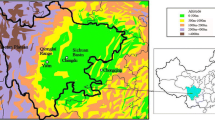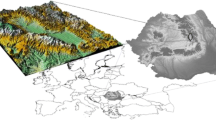Abstract
One hundred and ten samples of rainwater were collected for chemical analysis at the summit of Huangshan Mountain, a high-altitude site in East China, from July 2010 to June 2011. The volume-weighted-mean (VWM) pH for the whole sampling period was 5.03. SO 2−4 and Ca2+ were the most abundant anion and cation, respectively. The ionic concentrations varied monthly with the highest concentrations in winter/spring and the lowest in summer. Evident inter-correlations were found among most ions, indicating the common sources for some species and fully mixing characteristics of the alpine precipitation chemistry. The VWM ratio of [SO 2−4 ]/[NO −3 ] was 2.54, suggesting the acidity of rainwater comes from both nitric and sulfuric acids. Compared with contemporary observations at other alpine continental sites in China, the precipitation at Huangshan Mountain was the least polluted, with the lowest ionic concentrations. Trajectories to Huangshan Mountain on rainy days could be classified into six groups. The rainwater with influencing air masses originating in Mongolia was the most polluted with limited effect. The emissions of Jiangxi, Anhui, Zhejiang and Jiangsu provinces had a strong influence on the overall rain chemistry at Huangshan Mountain. The rainwater with influencing air masses from Inner Mongolia was heavily polluted by anthropogenic pollutants.
Similar content being viewed by others
References
Aas, W., and Coauthors, 2007: Air concentrations and wet deposition of major inorganic ions at five non-urban sites in China 2001–2003. Atmos. Environ., 41(8), 1706–1716.
Aleksic, N., K. Roy, G. Sistla, J. Dukett, N. Houck, and P. Casson, 2009: Analysis of cloud and precipitation chemistry at Whiteface Mountain, NY. Atmos. Environ., 43(17), 2709–2716.
Baez, A. P., R. D. Belmont, and H. G. Padilla, 1997: Chemical composition of precipitation at two sampling sites in Mexico: A 7-year study. Atmos. Environ., 31(6), 915–926.
Brankov, E., S. Trivikrama, and P. P. Steven, 1998: A trajectoryclustering-correlation methodology for examining the longrange transport of air pollutants. Atmos. Environ., 32, 1525–1534.
Cheng, Y., Y. Liu, M. Huo, Q. Sun, H. Wang, Z. Chen, and Y. Bai, 2011: Chemical characteristics of precipitation at Nanping Mangdang Mountain in eastern China during spring. Journal of Environmental Sciences, 23(8), 1350–1358.
China Meteorological Administration (CMA), 2005: Standard Operation Manual for Acid Rain Monitoring. Meteorological Publishing House, Beijing, 66 pp. (in Chinese)
Ding, G., X. Ji, X. Fang, J. Fu, and F. Wu, 1991: Characters of cloud-fog water in Lu Shan Mountain. Acta Meteorologia Sinica, 49(2), 190–197. (in Chinese)
Dorling, S. R., T. D. Davies, and C. E. Pierce, 1992: Clusteranalysis — a technique for estimating the synoptic meteorological controls on air and precipitation chemistry-method and applications. Atmos. Environ., 26(14), 2575–2581.
Draxler, R. R., 1997: Description of the HYSPLIT4 modeling system. NOAA Technical Memorandum, 24 pp.
Huang, K., G. S. Zhuang, C. Xu, Y. Wang, and A. Tang, 2008: The chemistry of the severe acidic precipitation in Shanghai, China. Atmospheric Research, 89(1–2), 149–160.
Huang, M., S. Liu, and U. Hiromasa, 1993: Comparison and analysis of the chemical characteristics of precipitation in China and Japan. Scientia Atmospheric Sinica, 17(1), 27–38. (in Chinese)
Lafrenière, M. J., and K. E. Sinclair, 2011: Snowpack and precipitation chemistry at a high altitude site in the Canadian Rocky Mountains. J. Hydrol., 409, 737–748.
Li, Y., J. Tang, X. Yu, X. Xu, H. Cheng, and S. Wang, 2012: Characteristics of precipitation chemistry at Lushan Mountain, East China: 1992–2009. Environmental Science and Pollution Research, 19(6), 2329–2343.
Liu, J. Q., C. William, and G. P. Wu, 1993: Study of precipitation background value in Lijiang, China. China Environmental Science, 13(4), 246–251. (in Chinese)
Menz, F. C., and H. M. Seip, 2004: Acid rain in Europe and the United States: An update. Environmental Science & Policy, 7, 253–265.
Özsoy, T., P. Türker, and S. Örnektekin, 2008: Precipitation chemistry as an indicator of urban air quality in Mersin, North-Eastern Mediterranean Region. Water, Air, and Soil Pollution, 189(1–4), 69–83.
Richter, A., J. P. Burrow, H. Nü, C. Granier, and U. Niemeier, 2005: Increase in tropospheric nitrogen dioxide over China observed from space. Nature, 437, 129–132.
Shi, C. E., X. L. Deng, B. W. Wu, J. Hong, S. Zhang, and Y. J. Yang, 2013: Characteristics of precipitation pH and conductivity at Mt. Huang. Environmental Science, 34(5), 1964–1972. (in Chinese)
Sun, M., Y. Wang, T. Wang, S. Fan, W. Wang, P. Li, J. Guo, and Y. Li, 2010: Cloud and the corresponding precipitation chemistry in south China: Water-soluble components and pollution transport. J. Geophys. Res., 115, D22303, doi: 10.1029/2010JD014315.
Tang, A., G. Zhuang, Y. Wang, H. Yuan, and Y. Sun, 2005: The chemistry of precipitation and its relation to aerosol in Beijing. Atmos. Environ., 39, 3397–3406.
Tang, J., H. S. Xue, X. L. Yu, H. B. Cheng, X. B. Xu, X. C. Zhang, and J. Ji, 2000: The preliminary study on chemical characteristics of precipitation at Mt. Waliguan. Acta Scientiae Circumstantiae, 20(4), 420–425. (in Chinese)
Tang, J., X. B. Xu, Z. B. Yang, J. Ba, and S. F. Wang, 2008: The conductivity additivity of ionic components in precipitation and its application to the data evaluation of acid rain monitoring. Journal of Applied Meteorological Science, 19, 1–8. (in Chinese)
Wai, K. M., N. H. Lin, S. H. Wang, and Y. Dokiya, 2008: Rainwater chemistry at a high-altitude station, Mt. Lulin, Taiwan: Comparison with a background station, Mt. Fuji. J. Geophys. Res., D06305, doi: 10.1029/2006JD008248.
Wang, W., and P. Xu, 2009: Research progress in precipitation chemistry in China. Progress in Chemistry, 21(2–3), 266–281.
Wang, Y., K.M. Wai, J. Gao, X. Liu, T. Wang, and W. Wang, 2008: The impacts of anthropogenic emissions on the precipitation chemistry at an elevated site in North-eastern China. Atmos. Environ., 42, 2959–2970.
Watanabe, K., Y. Takebe, N. Sode, Y. Igarashi, H. Takahashi, and Y. Dokiya, 2006: Fog and rain water chemistry at Mt. Fuji: A case study during the September 2002 campaign. Atmospheric Research, 82(3–4), 652–662.
Winiwarter, W., H. Puxbaum, W. Schöner, R. Böhm, R. Werner, W. Vitovec, and A. Kasper, 1998: Concentration of ionic compounds in the wintertime deposition: Results and trends from the Austrian Alps over 11 years (1983–1993). Atmos. Environ., 32(23), 4031–4040.
WMO GAW Precipitation Chemistry Science Advisory Group, 2004: Manual for the GAW Precipitation Chemistry Programme: Guidelines, data quality objectives and standard operating procedures. WMO TD No. 1251, 170pp.
Xue, H., and J. L. Schnoor, 1994: Acid deposition and lake chemistry in southwest China. Water, Air and Soil Pollution, 75, 61–78.
Zhang, Y., and Y. Qin, 1998: The chemical characteristics of springtime precipitation in Lushan mountains, East China. J. Appl. Meteor., 37, 1143–1152.
Zhao, Z. P., L. D. Tian, E. Fischer, Z. Q. Li, and K. Q. Jiao, 2008: Study of chemical composition of precipitation at an alpine site and a rural site in the Urumqi River Valley, Eastern Tien Shan, China. Atmos. Environ., 42(39), 8934–8942.
Author information
Authors and Affiliations
Corresponding author
Rights and permissions
About this article
Cite this article
Shi, C., Deng, X., Yang, Y. et al. Precipitation chemistry and corresponding transport patterns of influencing air masses at Huangshan Mountain in East China. Adv. Atmos. Sci. 31, 1157–1166 (2014). https://doi.org/10.1007/s00376-014-3189-1
Received:
Revised:
Accepted:
Published:
Issue Date:
DOI: https://doi.org/10.1007/s00376-014-3189-1




